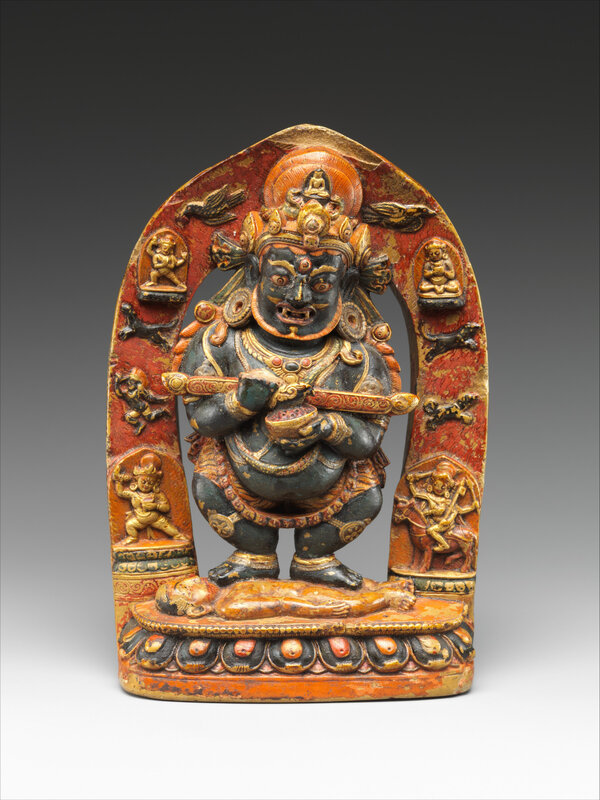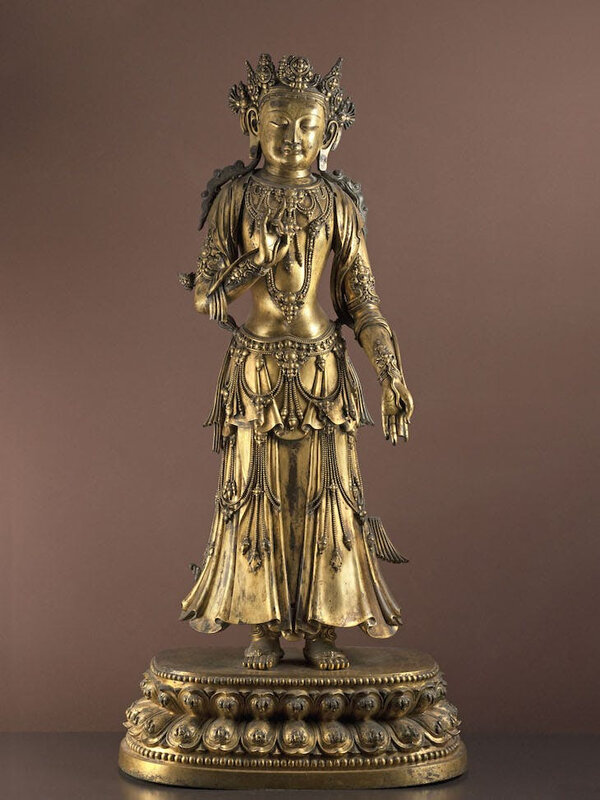Exhibition illustrates how Tibetan Buddhism empowered rulers through exquisite artworks
Hevajra (central detail); China; Ming dynasty, Yongle Period, ca. 1417–1423; silk embroidery; 81 x 131 cm; Pritzker Collection.
NEW YORK, NY.- Religion has influenced and empowered countless political leaders throughout history, and Tibetan Buddhism is no exception. “Faith and Empire: Art and Politics in Tibetan Buddhism” is the first exhibition of its kind to explore Tibetan Buddhism’s dynamic political role in the empires of Asia from the 7th to the early 20th century.
The exhibition places Himalayan art in a larger global context and sheds light on a little-known aspect of Tibetan Buddhism related to power, one that may run counter to popular perceptions yet is critical to understanding its importance on the world stage. Tibetan Buddhism offered a divine means to power and legitimacy to rule, with images serving as a means of political propagation and embodiments of power. Artworks on view in the exhibition, many for the first time in the United States, illustrate empires that not only embraced Tibetan Buddhism but were empowered by its masters, ritual magic, and religious artwork.
Bodhisattva Manjushri as Tikshna-Manjushri; China; Ming dynasty (1368–1644), Yongle reign mark (1403–1424); gilt brass, lost-wax casting; 7 1/2 x 4 3/4 x 3 1/2 in. (19.1 x 12.1 x 8.9 cm); The Metropolitan Museum of Art; Rogers Fund, 2001; 2001.59.
“In the West, Buddhism has often been romanticized as an unchanging passive tradition, but historically this was not the case. In Tibet, religion and politics were so intertwined as to be inseparable. For over a millennium Tibetan Buddhism was an active force in politics, both as a means to claim the right to rule and the magical means to take it,” said Karl Debreczeny, Senior Curator at the Rubin Museum. “‘Faith and Empire’ brings together more than 60 remarkable works of art —many from the highest levels of imperial court production— that illuminate the ways in which art and religion had a tremendous impact on politics in the courts of North Asia.”
Artwork highlights include a set of 8th-century gilt-silver drinking vessels from the Tibetan Empire; an early 13th-century wrathful icon made of silk and ornamented with tiny seed pearls; a 4 ½-foot-tall 680-pound gilt-bronze bodhisattva from the early 15th-century Ming court; and a 19th-century 8-feet-wide Mongolian depiction of the final battle against the heretics and nonbelievers. The exhibition is arranged chronologically, beginning with the Tibetan Empire in the 7th century, and includes sections on the Tangut kingdom of Xixia, the Mongol Empire, the Chinese Ming dynasty, the rule of the Dalai Lamas, and the Manchu Qing dynasty.
Panjaranatha Mahakala; China; Ming dynasty (1368–1644), late 15th century; distemper on cotton, mounted with silk brocade; 62 1/2 x 48 in. (158.8 x 121.9 cm); Museum of Fine Arts, Boston; William Sturgis Bigelow Collection; 12.47 (HAR 87211); photograph © 2019 Museum of Fine Arts, Boston
The exhibition will be accompanied by a publication, an audio guide, a conference (the weekend of April 6th), and other public programming.
“Faith and Empire” is the first exhibition in the Rubin’s yearlong thematic exploration of power, focusing on how visitors can activate the power that exists within and between us. The Rubin Museum’s 2019 exhibitions and programs highlight multiple perspectives and seek to empower visitors to think about their role as individuals and as a collective in creating, maintaining, and challenging existing systems of power.
“Faith and Empire” is curated by Karl Debreczeny and supported by Fred Eychaner, Zhou Yu Quan, the Zhiguan Museum of Art, Lisina M. Hoch, the Ellen Bayard Weedon Foundation, the E. Rhodes & Leona B. Carpenter Foundation, Christopher Fussner, the Thomas and Frances Blakemore Foundation, the Neil Kreitman Foundation, Yury Khokhlov, Margot and Tom Pritzker, Carlton Rochell and Kathleen Kalista, and John Eskenazi.
Achala, King of the Wrathful Ones (early 13th century), Khara Khoto, Tangut Xia, Inner Mongolia. Photo: © Cleveland Museum of Art.
Panjaranatha Mahakala; Tibet; 14th century; steatite with color and gilding; 7 x 4 1/2 x 1 1/2 in. (17.8 x 11.4 x 3.8 cm); The Metropolitan Museum of Art; gift of Florence and Herbert Irving, 2015; 2015.500.4.18.
Bodhisattva (1402–24), probably Qutan Temple, Qinghai Province, China. Photo: © Stéphane Piera/Musée Cernuschi, Paris/Roger-Viollet.
Qubilai Khan Naming Phakpa Imperial Preceptor (late 15th–16th century), attributed to Khyentse Chenmo, Tibet. Art Gallery of Greater Victoria. Photo: Stephen Topfer.
Book Covers for the Bhadrakalpika with the Eight Auspicious Symbols, from the Yongle Edition of the Kangyur; China; Ming dynasty, Yongle period (1403–1424), ca. 1410; red lacquer with incised decoration inlaid with gold (qiangjin); 28 1/2 x 10 1/2 in. (72.4 x 26.7 cm); The Metropolitan Museum of Art; gift of Florence and Herbert Irving, 2015; 2015.500.1.52a,b.
Kubera, Master of Horses and Guardian- General of the Southeast (c. 1516), China, Ming dynasty, Zhengde period (1506–1521). Musée des arts asiatiques—Guimet, Paris. Photo: © P. Pleynet/RMN-GrandPalais/Art Resource, NY.
Fifth Dalai Lama (1617–1682) with His Own Hand and Footprints; Tibet; late 17th century; 30 x 19 1/2 in. (76.2 x 49.5 cm); Musée des Arts Asiatiques-Guimet, Paris, France; MG19107. Photo: Thierry Ollivier © RMN-GrandPalais/Art Resource, NY.
Songsten Gampo (ca. 605–649); Tibet or neighboring region; ca. 19th century; papier-mâché, polychrome, leather ties; 15 3/8 x 9 1/2 x 5 5/8 in. Photo: John Bigelow Taylor; courtesy Bruce Miller Collection.
The Kingdom of Shambhala and Final Battle; Mongolia; 19th century; pigments on cotton; 44 x 87 1/2 in. (111.8 x 222.3 cm); Musée des Arts Asiatiques-Guimet, Paris, France; MG24416 (HAR 31352). Photo: Thierry Ollivier © RMN-GrandPalais/Art Resource, NY.

/https%3A%2F%2Fprofilepics.canalblog.com%2Fprofilepics%2F1%2F0%2F100183.jpg)
/https%3A%2F%2Fstorage.canalblog.com%2F03%2F02%2F119589%2F96711876_o.jpg)
/https%3A%2F%2Fstorage.canalblog.com%2F11%2F31%2F119589%2F94773502_o.jpg)
/https%3A%2F%2Fstorage.canalblog.com%2F20%2F83%2F119589%2F94772815_o.jpg)
/https%3A%2F%2Fstorage.canalblog.com%2F26%2F72%2F119589%2F75604929_o.jpg)
/https%3A%2F%2Fstorage.canalblog.com%2F59%2F60%2F119589%2F26458628_o.jpg)














/http%3A%2F%2Fstorage.canalblog.com%2F24%2F99%2F119589%2F95209809_o.jpg)
/http%3A%2F%2Fstorage.canalblog.com%2F27%2F02%2F119589%2F93049368_o.jpg)
/http%3A%2F%2Fstorage.canalblog.com%2F21%2F13%2F119589%2F93866158_o.jpg)
/image%2F1371349%2F20240417%2Fob_9708e8_telechargement.jpg)